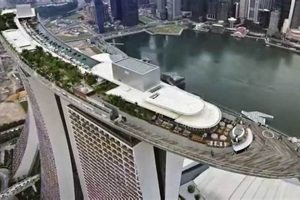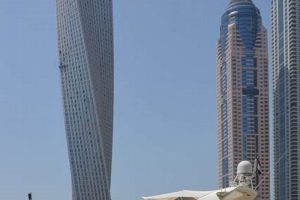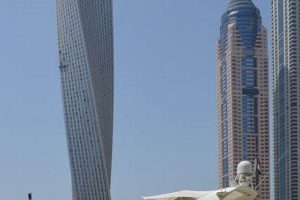Skyscrapers in China are high-rise buildings that have become a prominent feature of the country’s rapidly growing urban landscape. These structures are renowned for their architectural marvels, engineering feats, and contributions to the economic and social development of China.
The construction of skyscrapers in China has surged in recent decades, driven by urbanization, economic growth, and a desire to showcase the country’s architectural prowess. These buildings often serve multiple purposes, housing offices, residential units, retail spaces, and entertainment venues. They contribute significantly to the city’s skyline, becoming iconic landmarks and symbols of China’s modernization.
Some of the notable skyscrapers in China include the Shanghai Tower, the Ping An Finance Center, and the Guangzhou CTF Finance Centre. These buildings have set world records for height, sustainability, and design innovation. They have also played a pivotal role in transforming China’s urban centers into vibrant hubs of commerce, culture, and tourism.
1. Height
The remarkable height of skyscrapers in China is an integral aspect of their identity and global recognition. The construction of these towering structures is driven by several factors, including China’s rapid urbanization, economic growth, and desire to showcase architectural prowess. The height of these skyscrapers has significant implications:
- Economic impact: Tall buildings can accommodate more tenants and generate higher rental income, contributing to the city’s economy.
- Urban planning: Skyscrapers can optimize land use in densely populated areas, allowing for more efficient urban planning and infrastructure development.
- Architectural innovation: The pursuit of height has pushed architectural and engineering boundaries, leading to innovative designs and construction techniques.
- Cultural significance: Iconic skyscrapers have become symbols of Chinese cities, representing their economic power and modernity.
The Shanghai Tower, standing at 632 meters tall, is a prime example of China’s commitment to building tall and iconic structures. Its unique design, featuring a spiraling form and energy-efficient features, has made it a global architectural marvel. Other notable skyscrapers in China, such as the Ping An Finance Center and the Guangzhou CTF Finance Centre, also exemplify the country’s pursuit of architectural excellence and innovation.
In conclusion, the height of skyscrapers in China is not merely a physical attribute but also a reflection of the country’s economic vitality, urban planning strategies, architectural prowess, and cultural aspirations. These towering structures have transformed China’s skylines, contributing to its global recognition and economic development.
2. Design
The design of Chinese skyscrapers is a captivating blend of traditional influences and futuristic forms, reflecting the country’s rich cultural heritage and its embrace of innovation. This diversity in architectural styles adds to the unique identity of Chinese skyscrapers and contributes to their global recognition.
Traditional influences can be seen in the incorporation of elements such as curved roofs, intricate facades, and auspicious symbols. These elements pay homage to China’s architectural past and cultural traditions. For example, the Bank of China Tower in Hong Kong features a design inspired by bamboo stalks, representing growth and prosperity in Chinese culture.
On the other hand, futuristic forms are evident in the sleek lines, geometric shapes, and innovative use of materials. These designs showcase China’s commitment to architectural advancement and its to push the boundaries of design. The Shanghai Tower, with its spiraling form and energy-efficient features, exemplifies this futuristic approach.
The diverse architectural styles of Chinese skyscrapers are not merely aesthetic choices but also reflect the country’s cultural values and aspirations. Traditional influences evoke a sense of history and cultural continuity, while futuristic forms represent China’s embrace of modernity and progress. This combination creates a unique and dynamic architectural landscape that is distinctly Chinese.
In conclusion, the design of Chinese skyscrapers is a testament to the country’s cultural diversity and architectural prowess. The blend of traditional influences and futuristic forms creates a captivating and recognizable architectural style that reflects China’s rich past and its aspirations for the future.
3. Sustainability
The pursuit of sustainability has become an integral part of skyscraper development in China, reflecting a growing awareness of environmental responsibility and the need for sustainable urban development.
- Energy efficiency: Many skyscrapers in China incorporate energy-efficient technologies, such as double-glazed windows, LED lighting, and solar panels, to reduce their energy consumption and carbon footprint.
- Water conservation: Water-saving fixtures, rainwater harvesting systems, and greywater recycling are common features in sustainable skyscrapers in China, helping to conserve water resources.
- Green materials: Sustainable materials, such as bamboo, recycled steel, and low-VOC paints, are increasingly used in the construction of Chinese skyscrapers, contributing to a healthier indoor environment and reducing the building’s environmental impact.
- Green certifications: Many skyscrapers in China are pursuing green building certifications, such as LEED and BREEAM, to demonstrate their commitment to sustainability and reduce their environmental impact throughout their lifecycle.
The focus on sustainability in Chinese skyscrapers is not just a trend but a reflection of the country’s long-term commitment to sustainable development and its recognition of the importance of green buildings for the well-being of its citizens and the environment. Sustainable skyscrapers contribute to China’s goal of reducing its carbon emissions and building a more sustainable and livable urban future.
4. Mixed-use
The mixed-use nature of skyscrapers in China is a defining characteristic that sets them apart from traditional high-rise buildings and contributes significantly to their popularity and success. By combining residential, commercial, and retail spaces withi
n a single structure, these skyscrapers create vibrant and self-contained urban hubs that cater to the diverse needs of urban dwellers.
This mixed-use approach offers several advantages. Firstly, it promotes convenience and efficiency by allowing residents, workers, and visitors to live, work, shop, and dine within the same building complex. This reduces the need for commuting and creates a more sustainable and walkable urban environment. Secondly, mixed-use skyscrapers contribute to the economic vitality of the surrounding area by attracting businesses and creating employment opportunities.
One notable example of a mixed-use skyscraper in China is the Shanghai Tower, which combines office space, residential units, a hotel, a shopping mall, and cultural venues within its 128 floors. This vertical city offers its occupants a wide range of amenities and services, creating a vibrant and self-sufficient urban environment. Other examples include the Ping An Finance Center in Shenzhen, which houses offices, a retail podium, and a five-star hotel, and the Guangzhou CTF Finance Centre, which combines office space, apartments, and a shopping mall.
In conclusion, the mixed-use nature of skyscrapers in China is a key factor in their success and popularity. By creating vibrant urban hubs that cater to the diverse needs of urban dwellers, these buildings contribute to the economic vitality and social fabric of Chinese cities. As China continues to urbanize, mixed-use skyscrapers will likely play an increasingly important role in shaping the country’s urban landscape.
5. Economic drivers
Skyscrapers have emerged as powerful economic drivers in China, playing a pivotal role in attracting investments, stimulating economic growth, and transforming urban landscapes. Their contributions extend beyond their architectural grandeur, as they serve as hubs of commerce, innovation, and urban development.
- Increased investments and job creation: Skyscrapers attract substantial domestic and international investments, fueling economic growth. Their construction generates employment opportunities for architects, engineers, construction workers, and various other professionals.
- Enhanced tourism and hospitality: Iconic skyscrapers often become landmarks and tourist attractions, drawing visitors from around the globe. This influx of tourism stimulates the hospitality industry, including hotels, restaurants, and retail businesses, contributing to local economic growth.
- Business and financial centers: Many skyscrapers house corporate offices, financial institutions, and multinational companies. These skyscrapers serve as hubs for business activities, facilitating trade, commerce, and financial transactions, driving economic development.
- Mixed-use developments: Contemporary skyscrapers often incorporate mixed-use developments, combining residential, commercial, retail, and entertainment spaces. These developments create vibrant urban ecosystems that attract people to live, work, and spend, stimulating economic activity and enhancing the overall quality of life.
In conclusion, skyscrapers in China are not just architectural marvels but also significant economic drivers. Their ability to attract investments, stimulate growth, and transform urban landscapes makes them invaluable assets in China’s rapidly developing economy. As China continues to urbanize and grow economically, skyscrapers will undoubtedly continue to play a prominent role in shaping the country’s economic landscape.
6. Cultural landmarks
Skyscrapers in China have transcended their functional purpose and emerged as cultural landmarks, embodying the country’s economic achievements, architectural prowess, and cultural identity.
- Symbols of economic power: Iconic skyscrapers, such as the Shanghai Tower and the Ping An Finance Center, have become symbols of China’s economic rise and modernization. Their towering heights and impressive designs showcase the country’s technological advancements and economic strength.
- Architectural marvels: Chinese skyscrapers are renowned for their innovative designs and engineering feats. The CCTV Headquarters in Beijing, with its unique loop-like structure, and the Guangzhou CTF Finance Centre, with its spiraling facade, are testaments to the architectural ingenuity and creativity of Chinese architects.
- Cultural icons: Skyscrapers have become deeply intertwined with the cultural fabric of Chinese cities. They are featured prominently on postcards, travel brochures, and souvenirs, representing the city’s identity and aspirations. The Oriental Pearl Tower in Shanghai, for example, has become an iconic symbol of the city’s modernity and dynamism.
- Tourism destinations: Iconic skyscrapers have become major tourist attractions, drawing visitors from around the world. They offer observation decks, restaurants, and retail spaces, providing a unique experience of the city from an elevated perspective.
In conclusion, iconic skyscrapers in China have become more than just buildings; they have evolved into cultural landmarks that reflect the country’s economic power, architectural prowess, and cultural identity. These skyscrapers have transformed the skylines of Chinese cities and become symbols of the country’s modernization and progress.
7. Engineering feats
The construction of skyscrapers in China presents complex engineering challenges that push the boundaries of architectural possibilities. Engineers must overcome various obstacles to ensure the structural integrity, safety, and sustainability of these towering structures.
One of the primary challenges lies in the height of these buildings. Supertall skyscrapers, defined as buildings over 600 meters tall, require innovative structural systems to withstand strong winds and seismic forces. Engineers employ advanced technologies such as diagrid structures, outrigger systems, and tuned mass dampers to enhance the stability of these structures.
Another challenge is the foundation of these skyscrapers. The soft soil conditions in many Chinese cities necessitate the use of deep foundations, such as pile foundations or caisson foundations, to provide a stable base for the building. Engineers must carefully analyze the soil conditions and design foundations that can effectively transfer the building’s weight to the ground.
Furthermore, the sustainability of these skyscrapers is a key consideration. Engineers incorporate green building technologies, such as energy-efficient lighting and HVAC systems, to reduce the environmental impact of these buildings. They also employ sustainable materials and construction methods to minimize waste and promote resource conservation.
The engineering feats involved in constructing skyscrapers in China not only demonstrate the country’s technological advancements but also contribute to the development of new architectural techniques and building materials. These innovations have global implications, influencing the design and construction of tall buildings worldwide.
8. Urban transformat
ion
Skyscrapers have been instrumental in reshaping China’s urban landscapes, leading to the emergence of new business districts and residential areas. This transformative impact is closely intertwined with the rapid urbanization and economic growth experienced by China in recent decades.
- Creation of new business districts: Skyscrapers have played a central role in the development of new business districts in major Chinese cities. These districts, often referred to as central business districts (CBDs), are characterized by high concentrations of corporate headquarters, financial institutions, and multinational companies. The presence of skyscrapers in these districts provides ample office space, meeting the demands of businesses seeking a prestigious and accessible location.
- Expansion of residential areas: The construction of skyscrapers has also contributed to the expansion of residential areas in Chinese cities. Many skyscrapers incorporate residential units alongside commercial spaces, offering a convenient and luxurious living option for urban dwellers. These residential units often come with high-end amenities and facilities, creating exclusive and desirable neighborhoods.
- Improved infrastructure and connectivity: The development of skyscraper-centric districts has often been accompanied by significant investments in infrastructure and connectivity. Governments and urban planners recognize the importance of accessible transportation, reliable utilities, and modern amenities to support the growth and vitality of these areas. As a result, skyscrapers serve as catalysts for the improvement of urban infrastructure, benefiting not only the occupants of the buildings but also the surrounding communities.
- Rejuvenation of urban areas: In some cases, skyscrapers have been used as part of urban renewal projects, contributing to the revitalization of older or neglected areas. By attracting businesses, residents, and visitors to these areas, skyscrapers can stimulate economic growth and improve the overall quality of life. Notable examples include the redevelopment of the Pudong district in Shanghai and the creation of the new CBD in Beijing.
In conclusion, the urban transformation brought about by skyscrapers in China is a testament to their multifaceted impact on the built environment. Skyscrapers have not only reshaped skylines but have also played a pivotal role in creating thriving business districts, expanding residential areas, improving infrastructure, and rejuvenating urban spaces. As China continues to urbanize and its economy grows, skyscrapers will undoubtedly continue to be a driving force in the transformation of the country’s cities.
FAQs About Skyscrapers in China
Skyscrapers have become iconic symbols of China’s rapidly growing urban landscape, leading to inquiries and discussions about their impact, design, and construction. Here are some frequently asked questions and their answers to shed light on this topic:
Question 1: What are the tallest skyscrapers in China?
As of 2023, the three tallest skyscrapers in China are the Shanghai Tower (632 meters), the Ping An Finance Center (599 meters), and the Guangzhou CTF Finance Centre (530 meters). These buildings showcase China’s architectural prowess and engineering capabilities.
Question 2: What are the key design elements of Chinese skyscrapers?
Chinese skyscrapers exhibit a blend of traditional Chinese architectural influences and modern design principles. They often incorporate elements such as curved roofs, intricate facades, and auspicious symbols, while also featuring sleek lines, geometric shapes, and innovative materials.
Question 3: How do skyscrapers contribute to China’s economy?
Skyscrapers play a significant role in China’s economic development by attracting investments, generating employment opportunities, and stimulating growth in various sectors such as real estate, construction, and tourism. They also serve as hubs for business and financial activities.
Question 4: What are the sustainability features of Chinese skyscrapers?
Many skyscrapers in China prioritize sustainability by incorporating green building technologies and sustainable materials. They employ energy-efficient systems, water conservation measures, and green materials to reduce their environmental impact and promote a healthier indoor environment.
Question 5: How do skyscrapers impact urban development in China?
Skyscrapers have transformed urban landscapes in China, creating new business districts and residential areas. They contribute to the expansion of cities, improve infrastructure and connectivity, and stimulate economic growth. However, their impact on urban planning and social dynamics requires careful consideration.
Question 6: What are the future trends for skyscrapers in China?
The future of skyscrapers in China is expected to focus on innovation, sustainability, and mixed-use developments. There is a growing emphasis on eco-friendly designs, smart building technologies, and the integration of residential, commercial, and public spaces within skyscraper complexes.
Overall, skyscrapers in China are not just architectural marvels but also significant contributors to the country’s economic, social, and cultural development. Understanding their design, construction, and impact provides valuable insights into China’s urbanization and modernization.
Tips for Understanding Skyscrapers in China
To delve deeper into the world of skyscrapers in China, here are some informative tips to enhance your knowledge and understanding:
Tip 1: Explore Architectural Styles and Influences:Study the diverse architectural styles showcased in Chinese skyscrapers, ranging from traditional influences to futuristic designs. Research the cultural and historical context that shapes these architectural choices.Tip 2: Understand Engineering and Construction Challenges:Learn about the innovative engineering techniques used to construct supertall skyscrapers in China. Explore the challenges posed by height, wind loads, and seismic activity, and how engineers overcome them.Tip 3: Examine Economic Impacts and Urban Development:Analyze the role of skyscrapers in attracting investments and stimulating economic growth in China. Investigate how skyscrapers contribute to the expansion of business districts and residential areas, transforming urban landscapes.Tip 4: Focus on Sustainability and Green Building Practices:Discover the sustainability features incorporated into Chinese skyscrapers, such as energy-efficient systems and eco-friendly materials. Understand the importance of green building practices in promoting environmental consciousness and reducing carbon footprint.Tip 5: Appreciate Cultural Significance and Symbolism:Recognize the cultural significance of skyscrapers as landmarks and symbols of China’s economic power and modernization. Explore how skyscrapers reflect Chinese cultural values and aspirations.
These tips provide a framework for gaining a comprehensive understanding of skyscrapers in China. By exploring their architectural styles, engineering marvels, economic impacts, sustainability features, and cultural significance, you can appreciate the multifaceted role they play in shaping China’s urban landscape and economic development.
Conclusion
Skyscrapers have become synonymous with the rapidly evolving urban landscape of China, symbolizing its economic prowess, architectural ingenuity, and aspirations for modernity. This article has explored various aspects of skyscrapers in China, examining their design, construction, impact, and cultural significance.
From the towering heights of the Shanghai Tower to the sustainable features of the Ping An Finance Center, skyscrapers in China represent a fusion of architectural marvel and engineering excellence. They have transformed skylines, created new business districts, and expanded residential areas, contributing significantly to China’s urban development and economic growth. Moreover, their incorporation of green building technologies and sustainable materials reflects a growing awareness of environmental responsibility.
Understanding skyscrapers in China offers insights into the country’s urbanization, economic policies, and cultural values. As China continues on its path of development and modernization, skyscrapers will undoubtedly remain a defining feature of its urban landscape, shaping the future of its cities and serving as testaments to its architectural prowess and economic achievements.







